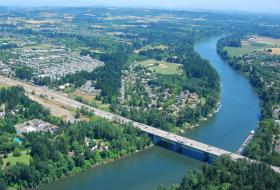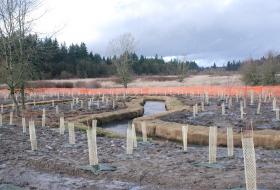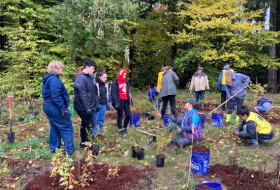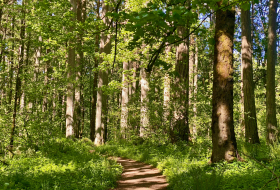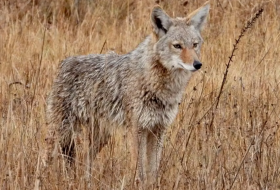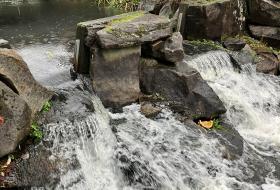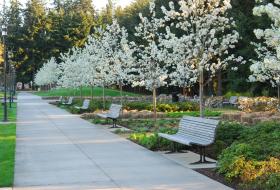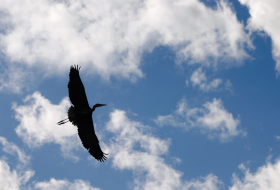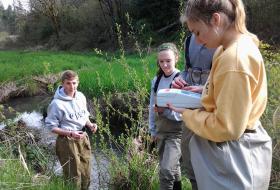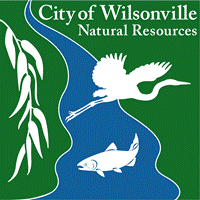Natural Resources
The Natural Resources Program helps maintain and promote a healthy environment in Wilsonville by providing long term care of local natural resources, such as streams, wetlands, and natural areas, the City is ensuring a sustainable future for the residents of Wilsonville.
Frequently Asked Questions
It is possible to have green lawns and relatively pest-free yards without using commercial fertilizers and pesticides. Try using an organic fertilizer as an alternative, or make your own compost fertilizer from food wastes and other biodegradable items. Alternatives to pesticides include soaps and horticultural oils, which can be made easily in your home or purchased. Metro offers tips, guides, and workshops for growing a natural and safe garden.
Creating a backyard wildlife habitat site that attracts songbirds, butterflies, and other interesting wildlife can be fun, peaceful, and rewarding. Replacing a barren lawn with beautiful wildflowers and other native plants will increase the appeal of your property and will provide a nurturing place for wildlife. It is important that you provide them with their three basic needs; food, water, and shelter. Here are some methods of providing these needs:
- Food: Bird feeders and hummingbird feeders are a good way to attract birds to your naturescaping yard; however, it is better to attract wildlife with natural growing sources of seeds, berries, and nectar. Plants that attract insects that birds like to eat are also a good way to provide food.
- Water: Because an open clean water source is an increasingly rare resource in urban environments, it is the feature most likely to attract wildlife. You can use something as simple as a saucer filled regularly with clean water or construct something more sophisticated like a pond, recirculating stream, or a fountain.
- Shelter: Birds and other creatures need protection from other predators and the weather. By providing dense evergreen trees, shrubs, and nesting boxes for birds, you supply them with a place to nest and raise their young.
The city restores and enhances local natural resource areas through volunteer tree planting events, stream restoration projects, and invasive species control, to name a few. Friends of Trees and the City of Wilsonville hold several tree planting events each year in an ongoing effort to restore riparian areas affected by erosion and to reduce invasive plant species in the parks.
In 2006, the city removed two culverts on Boeckman Creek that blocked fish passage and was causing extensive erosion. A pedestrian foot bridge was installed, and the stream and surrounding riparian area was restored.
In addition to these efforts, the city has partnered with Metro in the restoration and opening of Graham Oaks Nature Park. Metro and the City of Wilsonville worked with landscape architects, engineers, and interpretive specialists to develop detailed designs for Graham Oaks Nature Park. The park has several trail heads, one with parking, restrooms, and a covered shelter, along with other local neighborhood access points.
A trail system takes visitors through a variety of natural habitats including wetlands, conifer forests and the Oregon white oak woodlands and savanna that are growing at the site. The trail system will also connect to the proposed multiuse regional Tonquin Trail, envisioned to one day connect Graham Oaks Nature Park to Wilsonville neighborhoods and, eventually, the cities of Tualatin and Sherwood.
Invasive species can include plants, animals, or insects. They are species that have been introduced by humans or by other means to a location where they did not previously occur naturally. Invasive species can displace native species, and have the potential to significantly alter local ecosystems. Examples of invasive species that can be found in Wilsonville include: Himalayan blackberry, English ivy, nutria, and European starlings.
Riparian areas have been defined in several ways, but they are essentially the narrow section of land that border creeks, rivers, or other bodies of water. The health of riparian habitat is essential to a variety of species including birds, fish, reptiles, invertebrates, and mammals for feeding, nesting, cover, and breeding.
In some cases, these areas are the sole habitat for many species and are often of prime importance to threatened, endangered, and sensitive species. Although riparian areas may occupy only a small percentage of the area of a watershed, they represent an extremely important component of the overall landscape.
First, it is important to note that not all wildlife create conflicts. They behave instinctively doing whatever they need in order to survive. That being said, there are some things that you can do to prevent wildlife from infringing on your property. Basically, wildlife have three key necessities; food, water, and shelter. If you don’t provide these components you will lessen the odds of having to contend with them.
Often people send mixed messages by feeding or inadvertently sheltering wildlife so that they may enjoy viewing them but after an unpleasant experience they quickly alter their perception of particular species. If you have found your situation to be unmanageable, the Audubon Society of Portland offers Living with Urban Wildlife brochures and information.
A kolk pond is created by an underground tornado that occurs in deep flows of fast-moving water. About 15,000 years ago a vast lake known as Glacial Lake Missoula periodically burst through an ice dam releasing a catastrophic wall of water containing icebergs, boulders, and debris flooding the Tualatin and Willamette Valleys.
They tore huge potholes in the scablands and flung debris out of the floodwaters. Wilsonville’s Coffee Lake Wetlands sits in a kolk or depression in the bedrock scoured out by the prehistoric Glacial Lake Missoula Floods.
The city has adopted regulations that protect natural resource areas, such as the Significant Resource Overlay Zone (SROZ). The SROZ (Section 4.139 of the Wilsonville Development Code) protects wetlands, riparian corridors (areas that directly drain to a stream or river), and upland forests.
Development is prohibited in these protected natural resources areas, with the exception of relatively minor development impacts. In addition, the city has many important natural areas that are protected within local parks and open space areas.
Stormwater runoff occurs when precipitation from rain or snowmelt flows over impervious surfaces, such as driveways, sidewalks, and streets. When it is not properly managed, it can pick up pollutants along the way washing them into rivers and streams. Polluted stormwater runoff can have many adverse effects on plants, fish, animals, and people.





